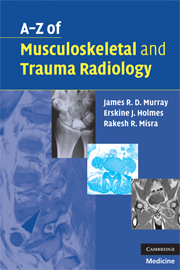Book contents
- Frontmatter
- Contents
- Acknowledgements
- Preface
- List of abbreviations
- Section I Musculoskeletal radiology
- Achilles tendonopathy/rupture
- Aneurysmal bone cysts
- Ankylosing spondylitis
- Avascular necrosis – osteonecrosis
- Femoral-head osteonecrosis
- Kienböck's disease
- Back pain – including spondylolisthesis/spondylolysis
- Bone cysts
- Bone infarcts (medullary)
- Charcot joint (neuropathic joint)
- Complex regional-pain syndrome
- Crystal deposition disorders
- Developmental dysplasia of the hip (DDH)
- Discitis and vertebral osteomyelitis
- Disc prolapse – PID – ‘slipped discs’ and sciatica
- Diffuse idiopathic skeletal hyperostosis (DISH)
- Dysplasia – developmental disorders
- Enthesopathy
- Gout
- Haemophilia
- Hyperparathyroidism
- Hypertrophic pulmonary osteoarthropathy
- Irritable hip/transient synovitis
- Juvenile idiopathic arthritis
- Langerhans-cell histiocytosis
- Lymphoma of bone
- Metastases to bone
- Multiple myeloma
- Myositis ossificans
- Non-accidental injury
- Osteoarthrosis – osteoarthritis
- Osteochondroses
- Osteomyelitis (acute)
- Osteoporosis
- Paget's disease
- Perthes disease
- Pigmented villonodular synovitis (PVNS)
- Psoriatic arthropathy
- Renal osteodystrophy (including osteomalacia)
- Rheumatoid arthritis
- Rickets
- Rotator-cuff disease
- Scoliosis
- Scheuermann's disease
- Septic arthritis – native and prosthetic joints
- Sickle-cell anaemia
- Slipped upper femoral epiphysis (SUFE)
- Tendinopathy – tendonitis
- Tuberculosis
- Tumours of bone (benign and malignant)
- Section II Trauma radiology
Psoriatic arthropathy
from Section I - Musculoskeletal radiology
Published online by Cambridge University Press: 22 August 2009
- Frontmatter
- Contents
- Acknowledgements
- Preface
- List of abbreviations
- Section I Musculoskeletal radiology
- Achilles tendonopathy/rupture
- Aneurysmal bone cysts
- Ankylosing spondylitis
- Avascular necrosis – osteonecrosis
- Femoral-head osteonecrosis
- Kienböck's disease
- Back pain – including spondylolisthesis/spondylolysis
- Bone cysts
- Bone infarcts (medullary)
- Charcot joint (neuropathic joint)
- Complex regional-pain syndrome
- Crystal deposition disorders
- Developmental dysplasia of the hip (DDH)
- Discitis and vertebral osteomyelitis
- Disc prolapse – PID – ‘slipped discs’ and sciatica
- Diffuse idiopathic skeletal hyperostosis (DISH)
- Dysplasia – developmental disorders
- Enthesopathy
- Gout
- Haemophilia
- Hyperparathyroidism
- Hypertrophic pulmonary osteoarthropathy
- Irritable hip/transient synovitis
- Juvenile idiopathic arthritis
- Langerhans-cell histiocytosis
- Lymphoma of bone
- Metastases to bone
- Multiple myeloma
- Myositis ossificans
- Non-accidental injury
- Osteoarthrosis – osteoarthritis
- Osteochondroses
- Osteomyelitis (acute)
- Osteoporosis
- Paget's disease
- Perthes disease
- Pigmented villonodular synovitis (PVNS)
- Psoriatic arthropathy
- Renal osteodystrophy (including osteomalacia)
- Rheumatoid arthritis
- Rickets
- Rotator-cuff disease
- Scoliosis
- Scheuermann's disease
- Septic arthritis – native and prosthetic joints
- Sickle-cell anaemia
- Slipped upper femoral epiphysis (SUFE)
- Tendinopathy – tendonitis
- Tuberculosis
- Tumours of bone (benign and malignant)
- Section II Trauma radiology
Summary
Characteristics
Affects 5%–10% patients with psoriasis.
This is a proliferative synovitis.
Early fibrosis is common.
Classified as a seronegative spondyloarthropathy.
HLA B27 is positive in the majority of patients.
May mimic rheumatoid arthritis.
Clinical features
Skin rash commonly precedes arthritis.
Nail changes include pitting, hyperkeratosis, ridging and subungal separation.
Joint changes are similar to rheumatoid arthritis although rheumatoid nodules are absent.
Characteristically a mild asymmetrical polyarthritis typically affecting the distal interphalageal joints of the hands and feet.
Bone destruction may be severe (arthritis mutilans).
Sacroiliitis may mimic ankylosing spondylitis.
Radiological features
Within the large joints, changes are similar to rheumatoid arthritis.
Bone density tends to be preserved.
Psoriatic dactylitis = soft-tissue swelling of entire digit – ‘sausage digit’.
Interphalangeal joint destruction secondary to erosions and periosteal new bone formation results in ‘pencil in cup’ deformity.
Sacroiliac erosions are common.
Management
Specialised care under the guidance of a rheumatologist.
Treatment aimed at symptom control. NSAIDS are the mainstay of treatment.
Immunosuppressant drugs (e.g. methotrexate) for resistant disease – current research therapies include anti-tumour necrosis factor.
Physiotherapy and the use of splintage can help prevent deformity and functional loss.
Most psoriatic arthropathy is burnt out in 10 years.
Surgery for pain, instability and to improve function (arthrodesis/arthroplasty).
- Type
- Chapter
- Information
- A-Z of Musculoskeletal and Trauma Radiology , pp. 119 - 121Publisher: Cambridge University PressPrint publication year: 2008



